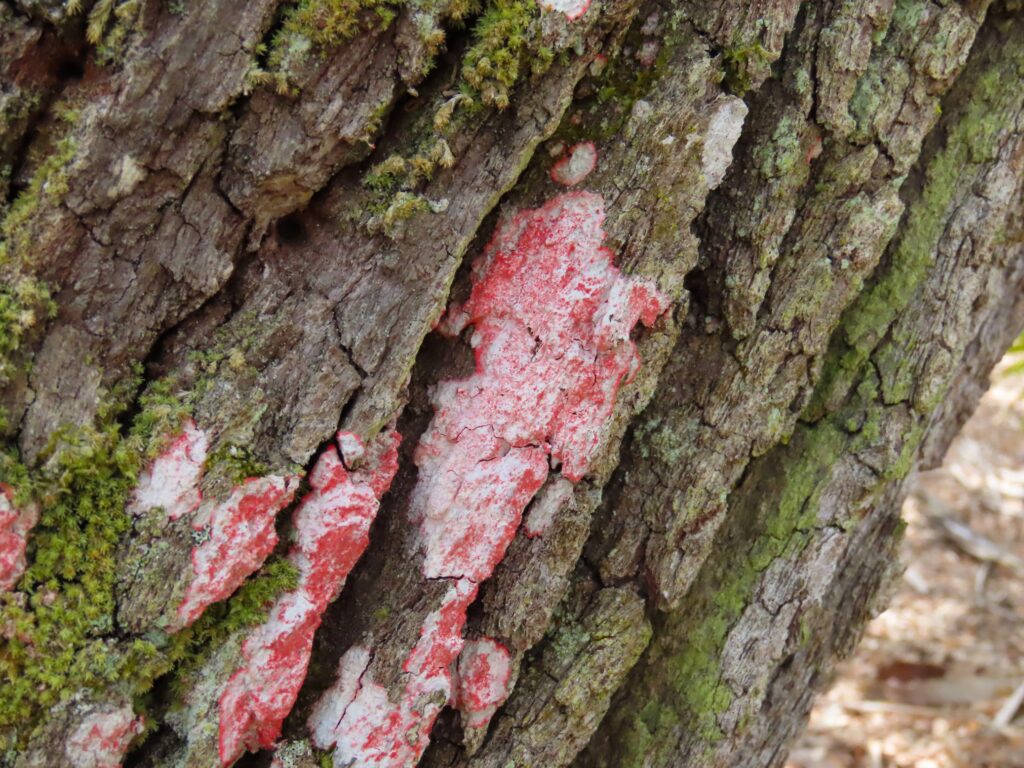
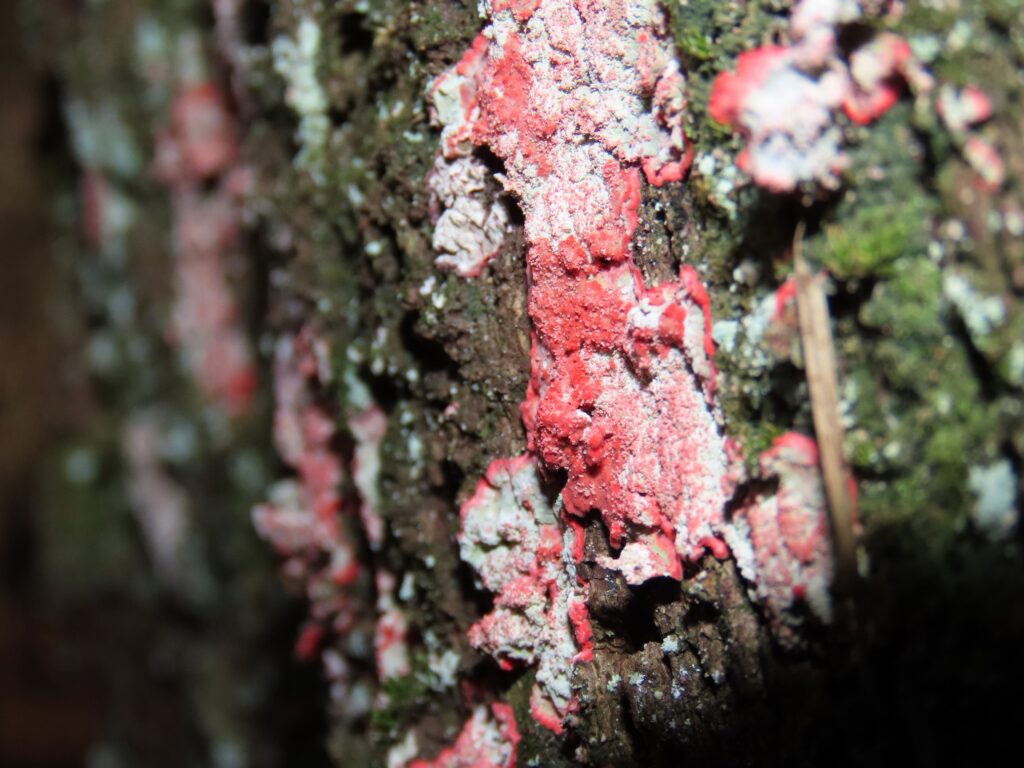
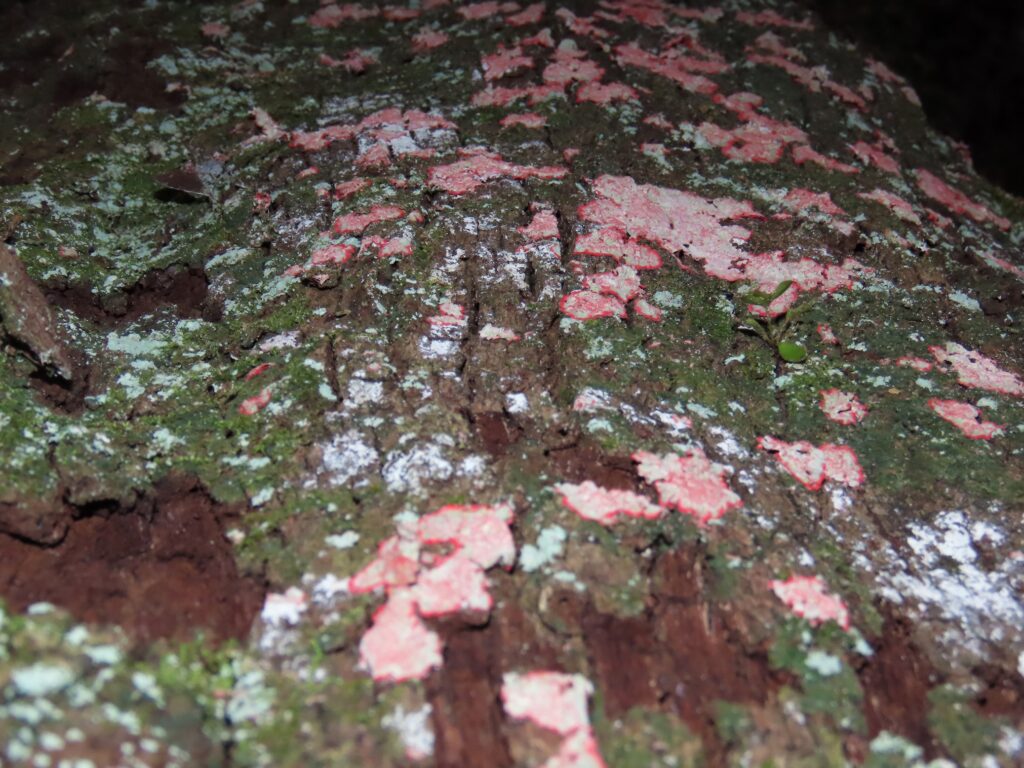
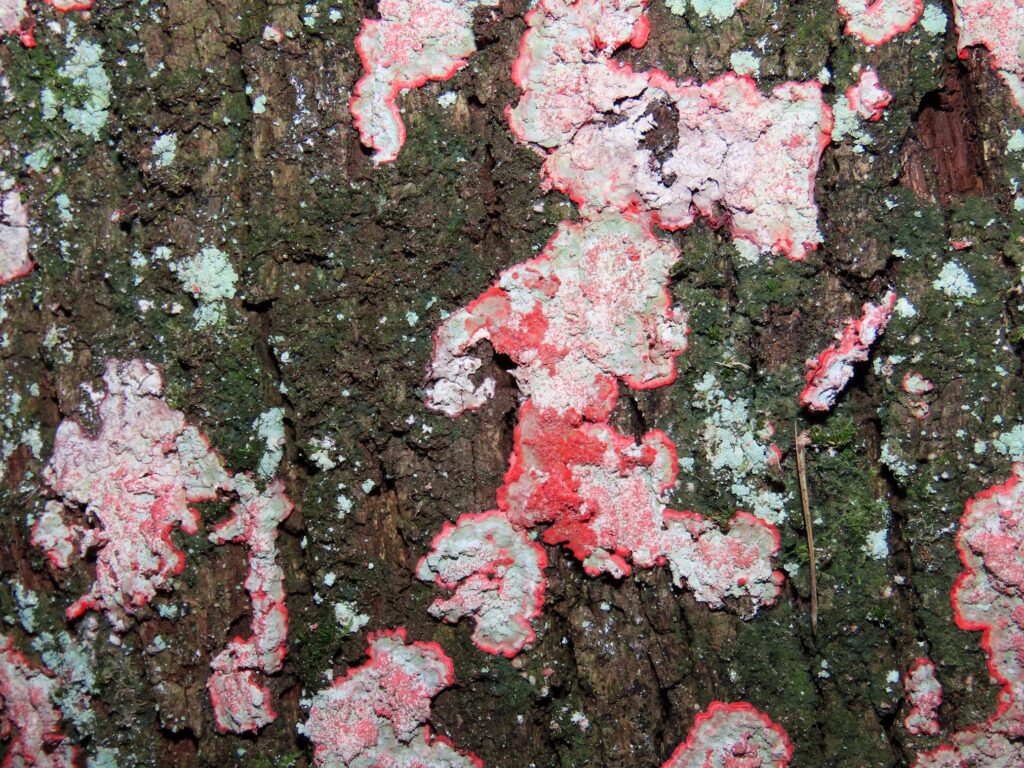
This week for Flora and Fauna Friday, we’re getting to know a delightfully festive fungus, the Christmas Lichen (Cryptothecia rubrocincta).
Christmas Lichen is found all along the coastline of the Deep South and across the Lowcountry. It’s a species that thrives in the humid and subtropical maritime forests of our Sea Islands. Christmas Lichen, like many lichens, is an epiphyte. It grows on the surface of a plant, using them as both scaffold and abode. Here on the Sea Islands, Christmas Lichen is most often encountered encrusting the bark of Live Oak, Water Oak, or Southern Magnolia limbs and trunks in deeply shaded forests, vying for real estate below the phoenix fronds of Resurrection Fern and between the swaying beards of Spanish Moss. Despite the oft crowded crowns of our maritime evergreens, it’s an easy species to spot. On smooth bark Christmas Lichen appears as a vibrant rose-red ring with a blush of red between on a palette of platinum-white, a clear and obvious bullseye for any eye to fall onto. On the blocky bark of Live Oaks, this pattern dissolves into a more uniform wash of white, like broad brushstrokes of paint, frosted with a dusting of rosy flakes.
Christmas Lichen is a fungus, but not just any fungus, it’s a lichen. Lichens are a special category of life. They are not one organism, but two unrelated walks of life, a fungus and an alga, living in deep symbiosis with each other. The alga photosynthesizes food and the fungus provides shelter and nutrition to the alga. We generally classify Lichens based on their fungal half, as it’s the organism we can actually see and measure, apart from variations in color and pattern. Lichens are almost always epiphytic and generally don’t produce “roots” (hyphae) into the surface they cling to. Lichens can grow practically anywhere and are extremely hardy to natural environmental extremes. Many grow on tree bark but others will grow on rocks and atop barren mineral soils. They absorb water from rain, dew, or fog and sponge nutrients from their surface, be that from detritus, dust, rain, or dissolved directly from raw rock. This epiphytic nature makes lichens extremely sensitive to air pollution. Many species, including Christmas Lichen, are almost impossible to find in urban areas and along major roads due to vehicle exhaust and smog. But in the secretive and shaded forests of Edisto Island, Christmas Lichen still provides a flush of hearty festive color to those who wander our woods in winter.





This week for Flora and Fauna Friday, we’re training our eyes and ears to the wetland edges for the fleeting signs of the Winter Wren (Troglodytes hiemalis).
While walking and winding with our waterways in winter, one should watch the wooded walls of wetlands and wallows for the wary Winter Wren. ‘Tis a tiny bird of swamps and swales that settles into the South, as the sunlight shrinks and the shade trees slumber. Beige and brown from bill to bobtail, it blends beautifully into the background and black ground of our bottomlands, unseen and unheard until the unknown approaches. At the detection of trespass, any hapless passerby, alarm bells begin to ring within the wetlands. The Winter Wren will explode into action unleashing a rapid volley of rattling and chattering as it bounces and bobs from bush to buttress in a beeline towards the offense. For a lucky few, they’ll get to view the Winter Wren unobstructed, perched atop a sunlit stump in all its cryptic glory. Yet for the rest of us the best we’ll get is fleeting sideways glances between the boughs at the bottom of a brush pile.
The Winter Wren is one of five species of Wren that call the Lowcountry home and it only hangs out here in the coldest month of the year. It shares a genus, and a bit of its likeness, with the Northern House Wren (Troglodytes aedon). The Winter Wren is distinct among our Wrens for its overall darker and more uniform plumage, tiny size, and its stubby tail. It’s also quite particular in its habitat preferences during our South Carolina winters, sticking almost exclusively to the soggy, shaded soils of our bottomlands, floodplains, backwaters, bogs, bays, and the brushy margins of shallow ponds. The Winter Wren’s calls are short, sharp, and higher pitched than other Wrens and it’s not afraid to voice complaints if you start tromping into its domain. They are almost always heard well before they are seen, often from some ever shrinking distance away as it bounds from tree base to tree base towards any uninvited guest. Winter Wrens have a vexing habit for bird watchers, staying low to the ground and rarely perching in full view, preferring to stay under cover while sneaking peaks between gaps in debris on the forest floor, rarely staying in one spot for more than a few seconds.
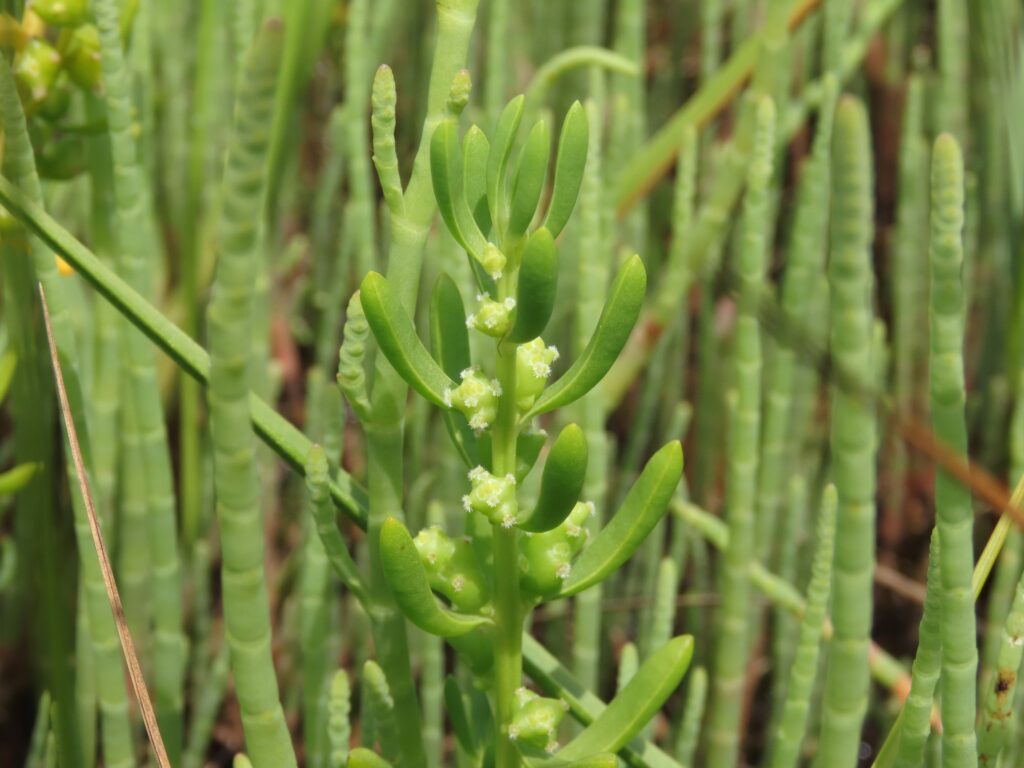
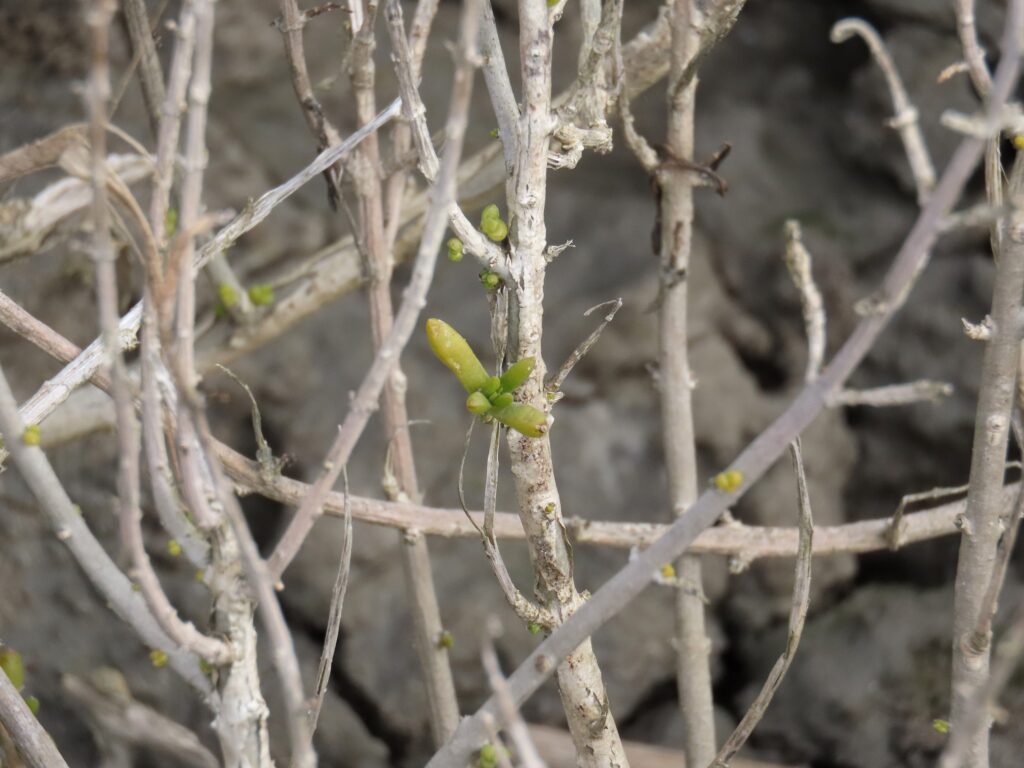
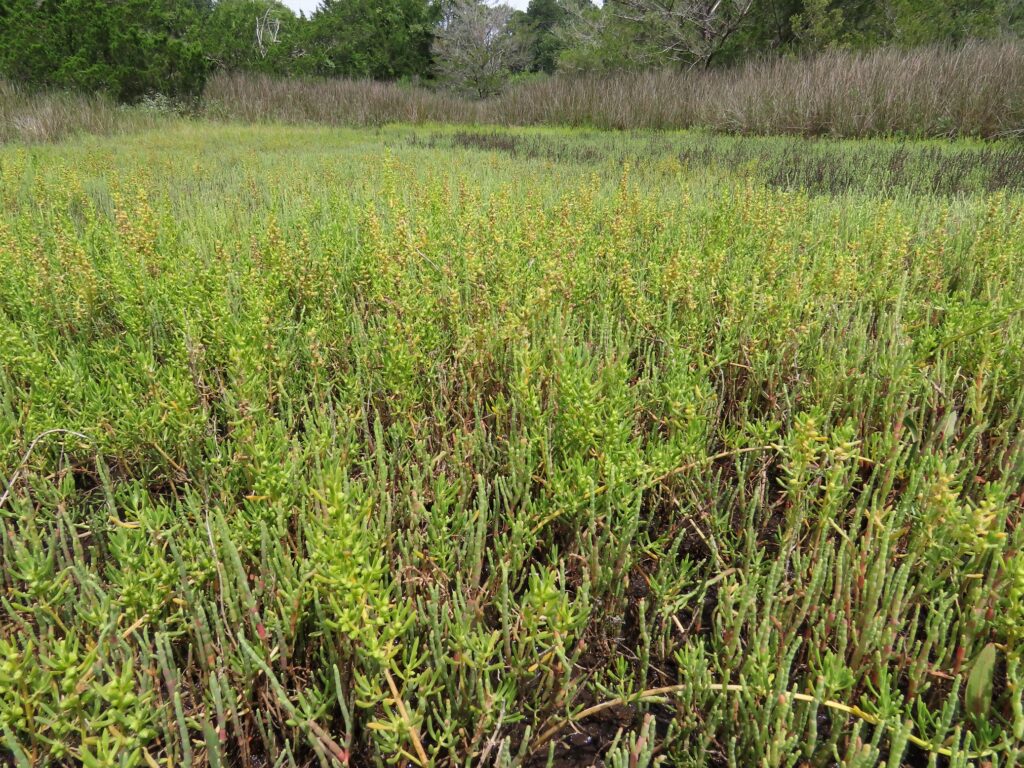
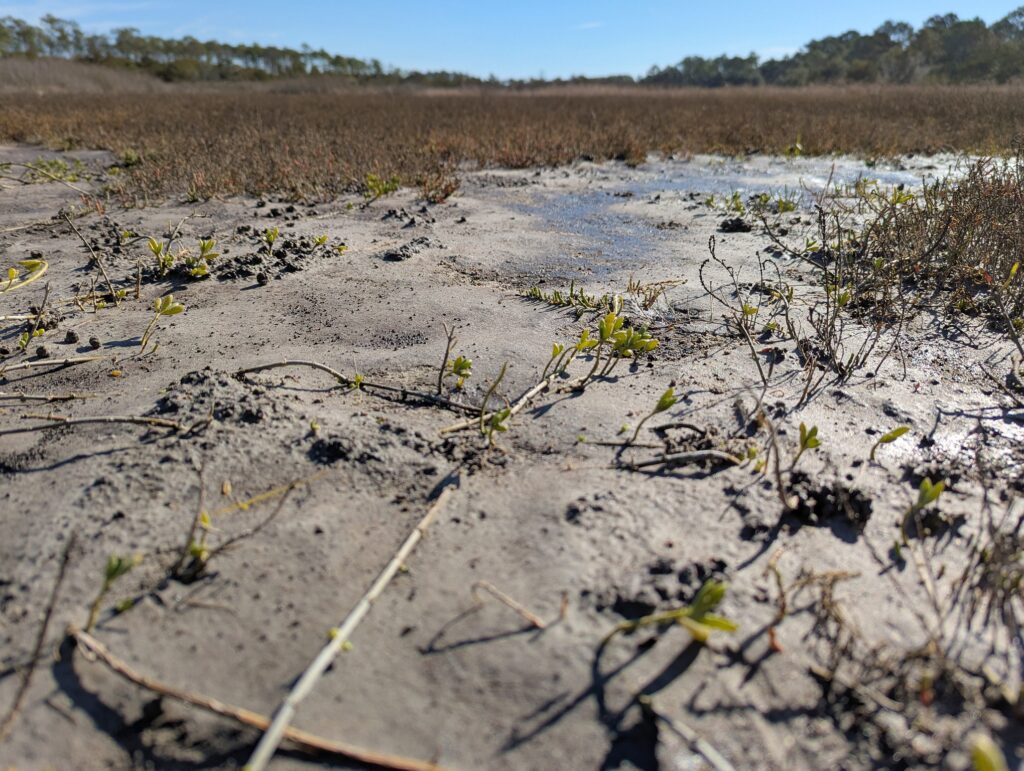
This week for Flora and Fauna Friday it’s a subtropical, salt-loving, seaside, succulent shrub, Saltwort (Batis maritima).
Saltwort can be sighted along the Gulf Coast of the United States and ranges naturally up the East Coast to just below the Santee River here in South Carolina. It’s mainly found behind our barrier islands, growing in the sand flats of their back marshes. Saltwort is a halophyte, a salt-lover, and grows in much the same habitat as our common Perennial Glasswort (Salicornia perennis). These two salty succulents often grow together, but Saltwort clings to the oceanfront much more tightly. This is because Saltwort thrives in a subtropical climate and in very high salinity. The sand flats of South Carolina’s barrier island back marshes check both those boxes. Their proximity to the Atlantic Ocean ensures both a regular supply of full strength seawater and a tempering tropical micro-climate throughout the winter.
Saltwort is a unique looking plant found in a unique habitat here in the Lowcountry. So it’s an easy one to pick out in the wild. Its leaves are opposite, yellow-green, succulent, cylindrical in cross-section, and often curve upward. Overall they’re about one-half to three-quarters of an inch in length and shaped somewhere between a tiny banana and a tiny green bean. Young Saltwort stems are also green and succulent but, as they age, they become woody and turn a pale gray-brown. These stems can either run along the ground or arch upward to about a foot in height. Saltwort blooms at the end of April and bears inconspicuous pale-green flowers in swollen, cylindrical clusters.
Similar to our Glassworts, Saltwort leaves are edible but taste quite salty. Its seeds are also high in oil content. Given these uses and its high salt tolerance, it has some experimental promise as a specialty oil crop in regions of the world with excessive soil salinity and saltwater intrusion. Saltwort is also a host plant for the Great Southern White butterfly (Ascia monuste), a tropical butterfly whose range is slowly expanding northward into the South Carolina coast.
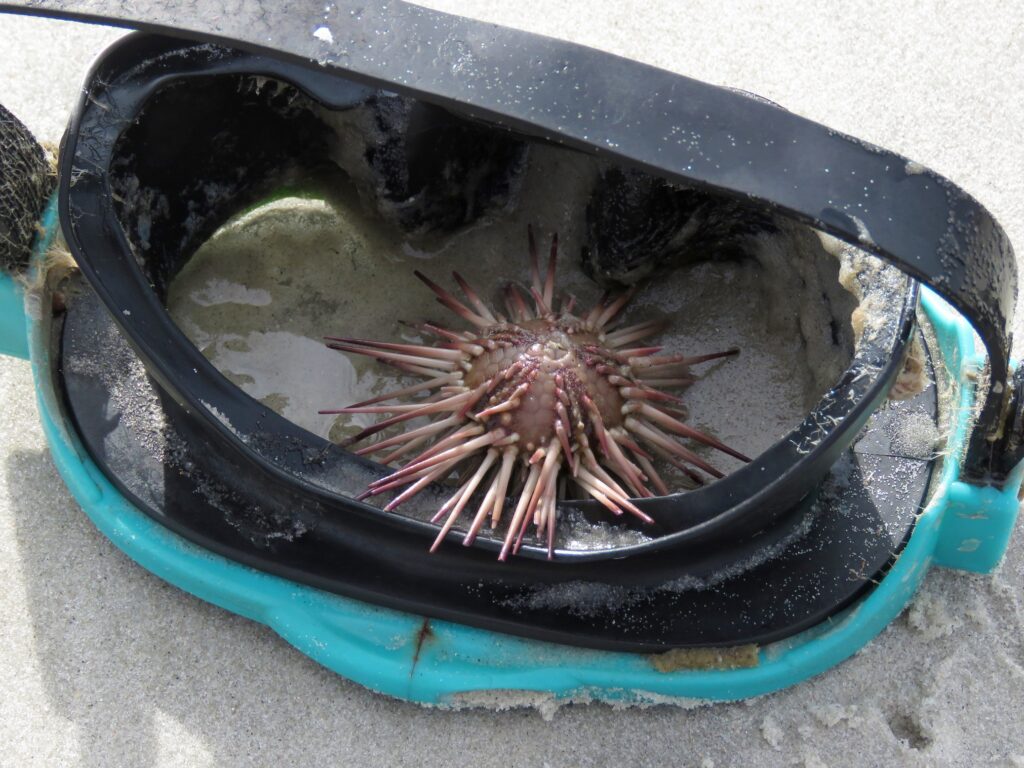
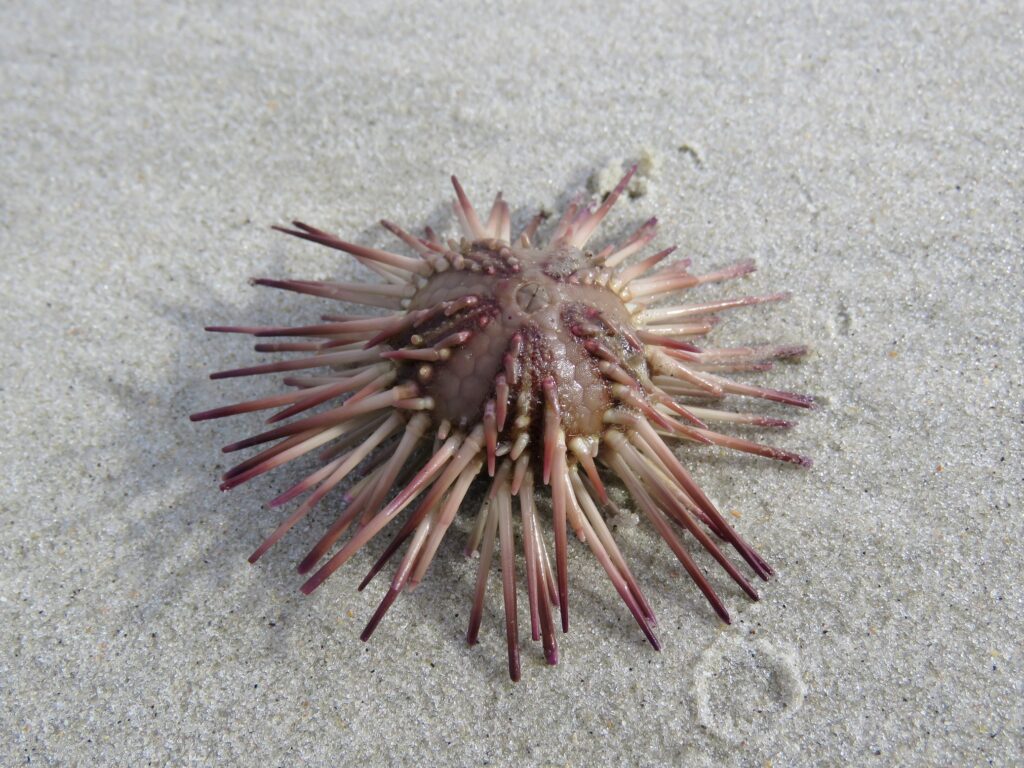
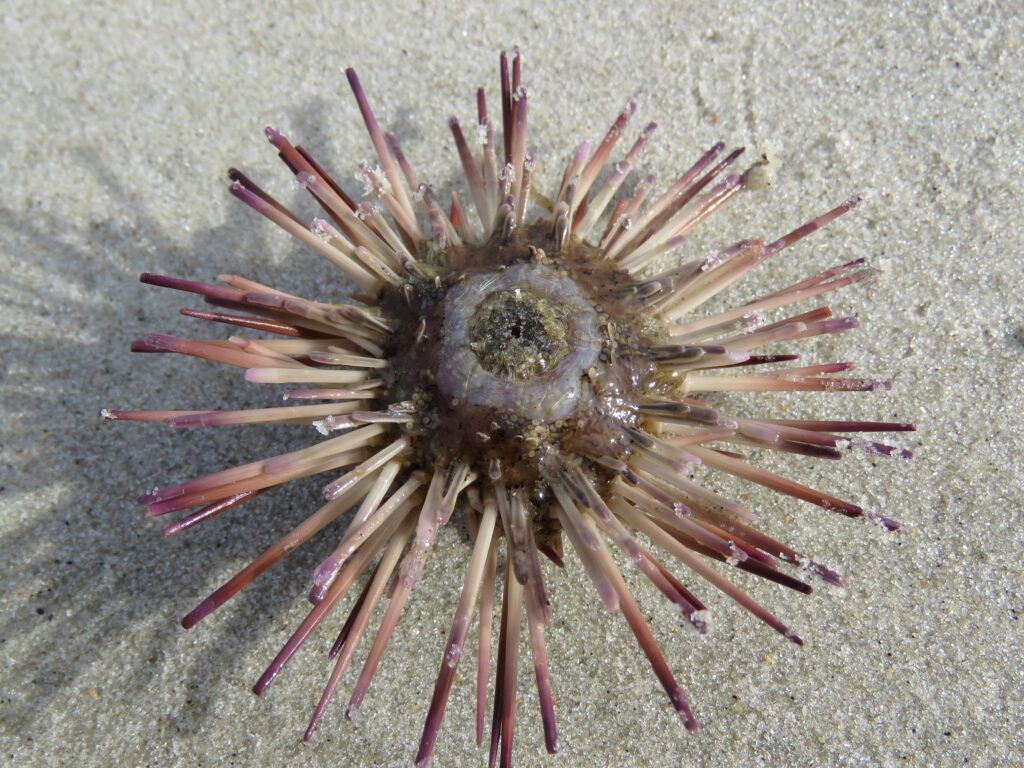
This week for Flora and Fauna Friday it’s the pincushion of the East Coast, the Atlantic Purple Sea Urchin (Arbacia puntulata).
The Atlantic Purple Sea Urchin is found all up and down the United States East Coast, from the Keys to Boston. It’s our most oft encountered Urchin on the Lowcountry’s coastline and can be found along the beachfront year round. They are readily recognized by their dark purple-brown, dome-like body studded in a profusion of stout pink-purple spines. Fully grown, this urchin is roughly four inches wide from spine to spine. However, more often than not, you’ll encounter not a live Urchin but its calcareous skeleton washed upon the beach. In Urchins, this is called a “test” and is the outer skeleton of their body that lies just below their skin. For Purple Sea Urchins, their test is about an inch-and-a-half wide and bone-white with five pairs of burgundy bands running from top to bottom.
Purple Sea Urchins live their lives in the intertidal zone right up near the beach, clinging to hard structures like the stones and pilings of jetties, groins, and piers. Below the waves they comb these hard surfaces for sessile plant and animal life, scraping away and eating anything edible encountered with their five-sided chisel-like beak. They can also be found nibbling on carrion they chance upon. Purple Sea Urchins use their spines to deter predators, lifting them upright and pointing them towards predators to discourage hungry mouths, like a phalanx of spears. They move around using a combination of short, blunt spines and flexible, tube feet on their underside. These propel them forward at a blistering pace of one mile per month, or about eight feet per hour.
The tiny tubular feet of the Purple Sea Urchin are a common trait to the Echinoderms, the Phylum of invertebrates to which all Urchins, Sand Dollars, Star Fish, Crinoids, and Sea Cucumbers belong. These tube feet are articulated using water pressure from the animal’s circulatory system, rather than muscles. Each foot is tipped with a tiny suction cup, allowing them to grab onto a surface or manipulate a piece of food. Some of the tube feet of the Purple Sea Urchin can also secrete a strong, but reversible, adhesive. This allows them to glue themselves to hard surfaces during rough waters and stay attached at any angle indefinitely.
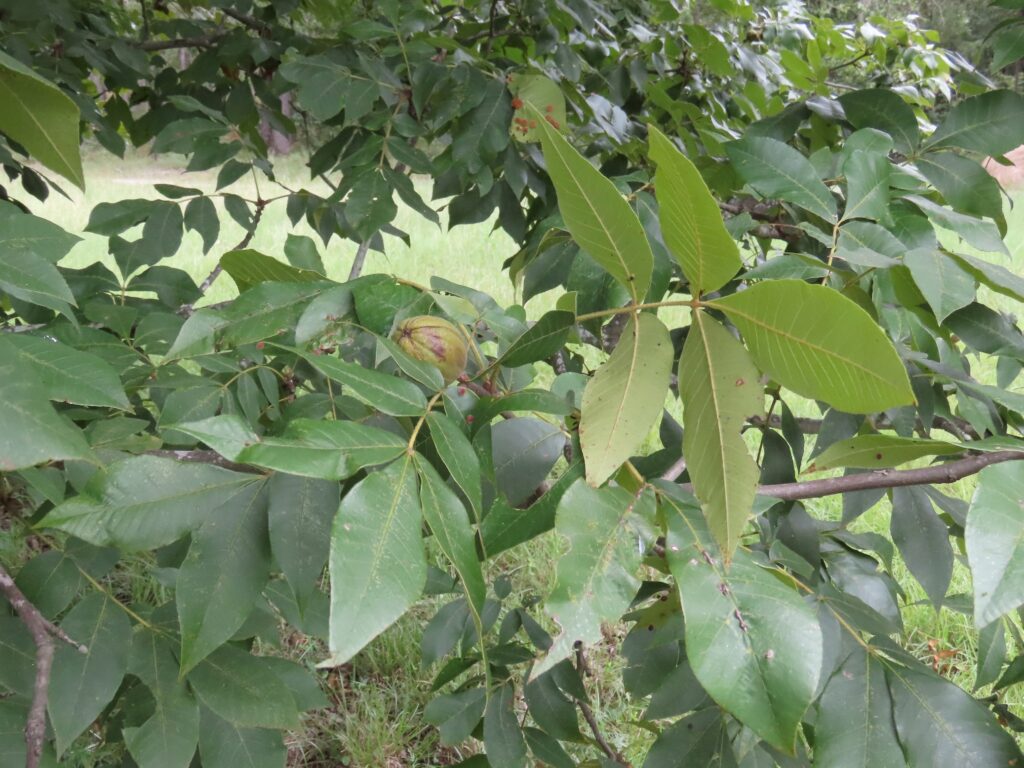
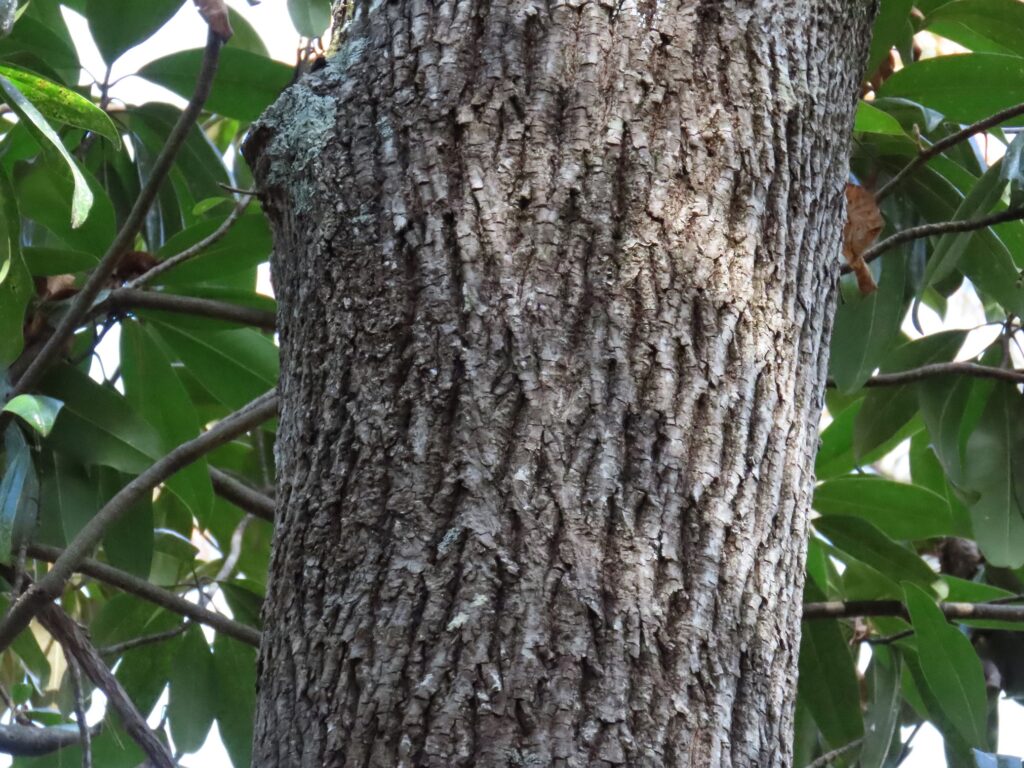
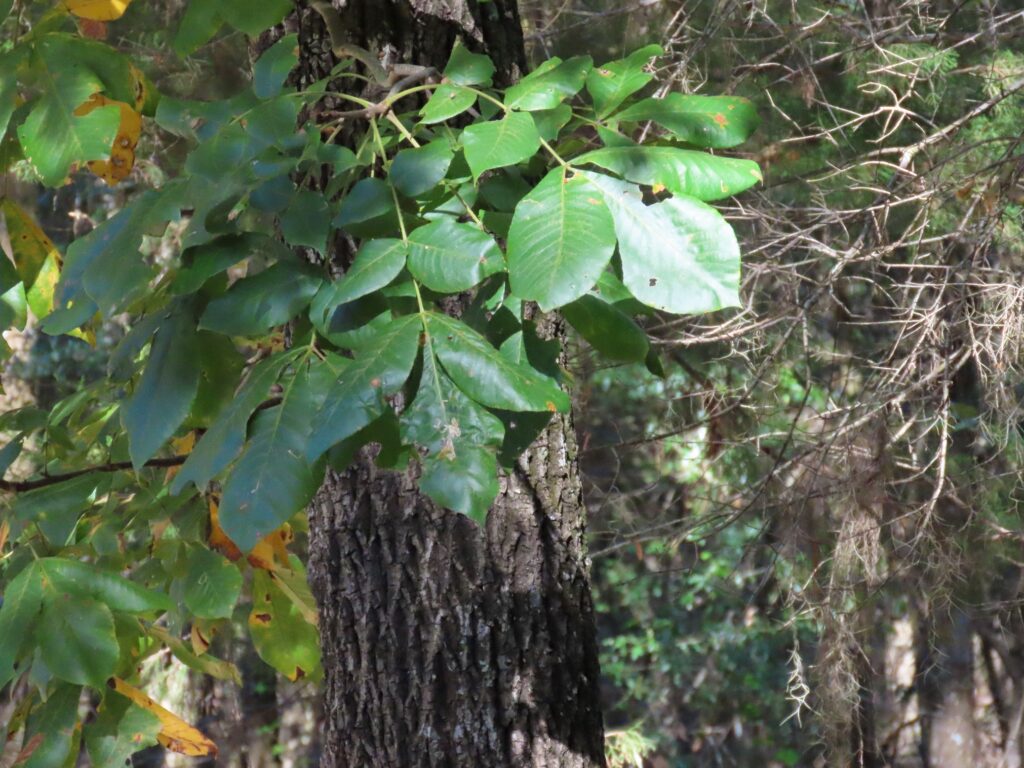
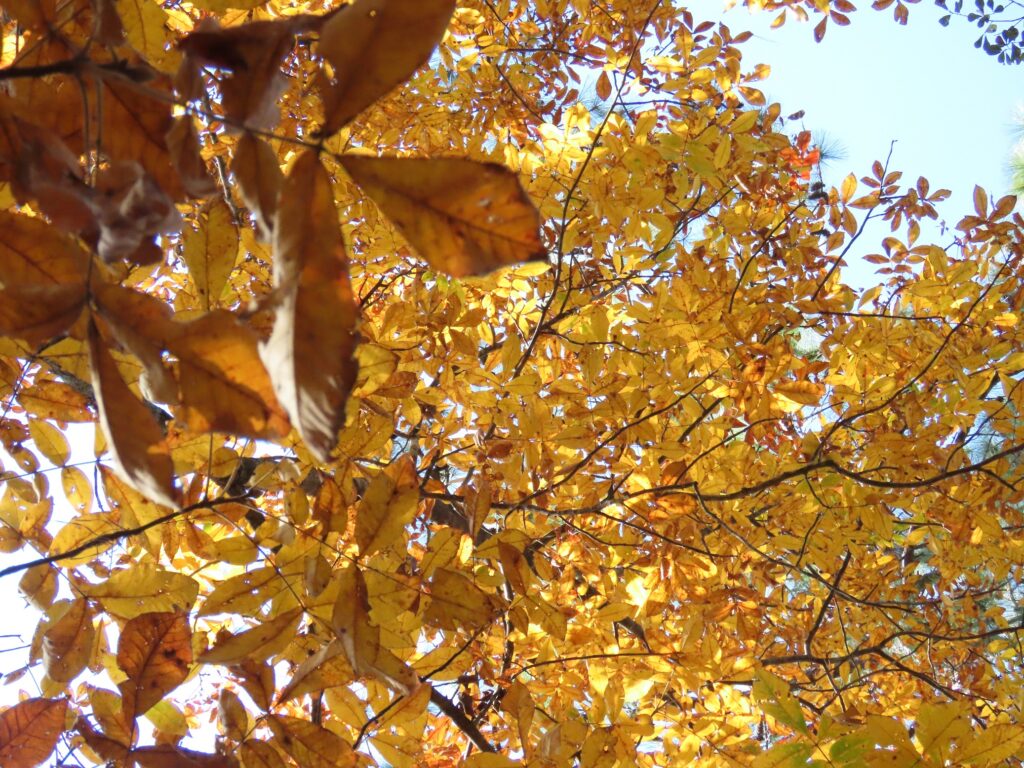
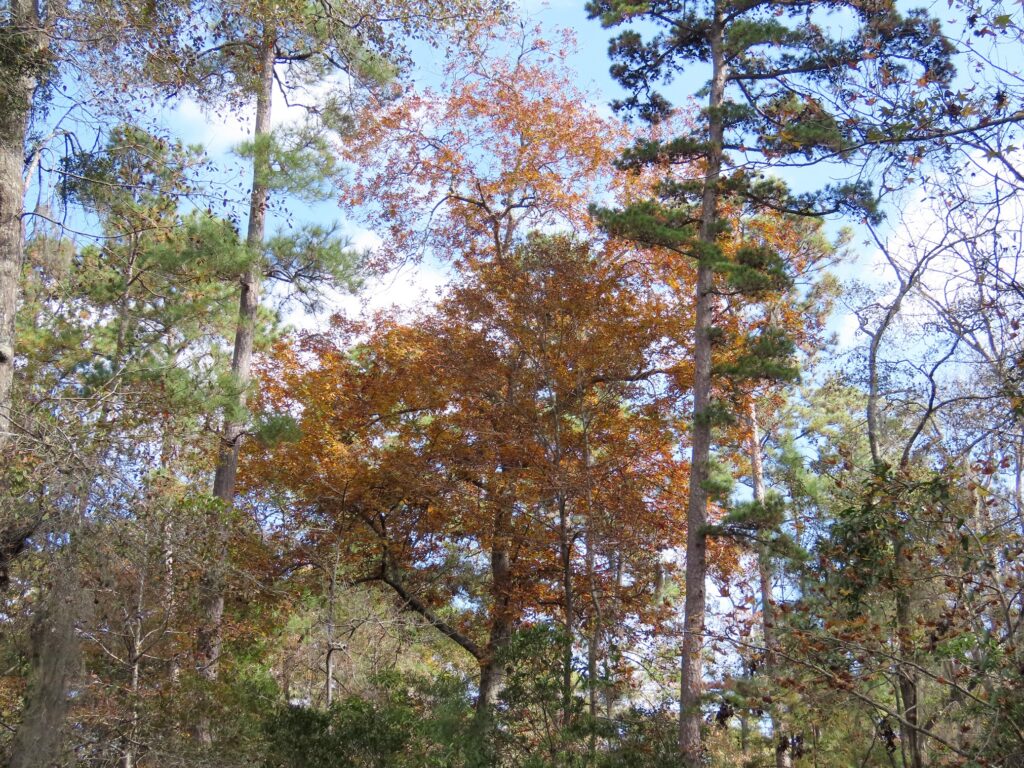
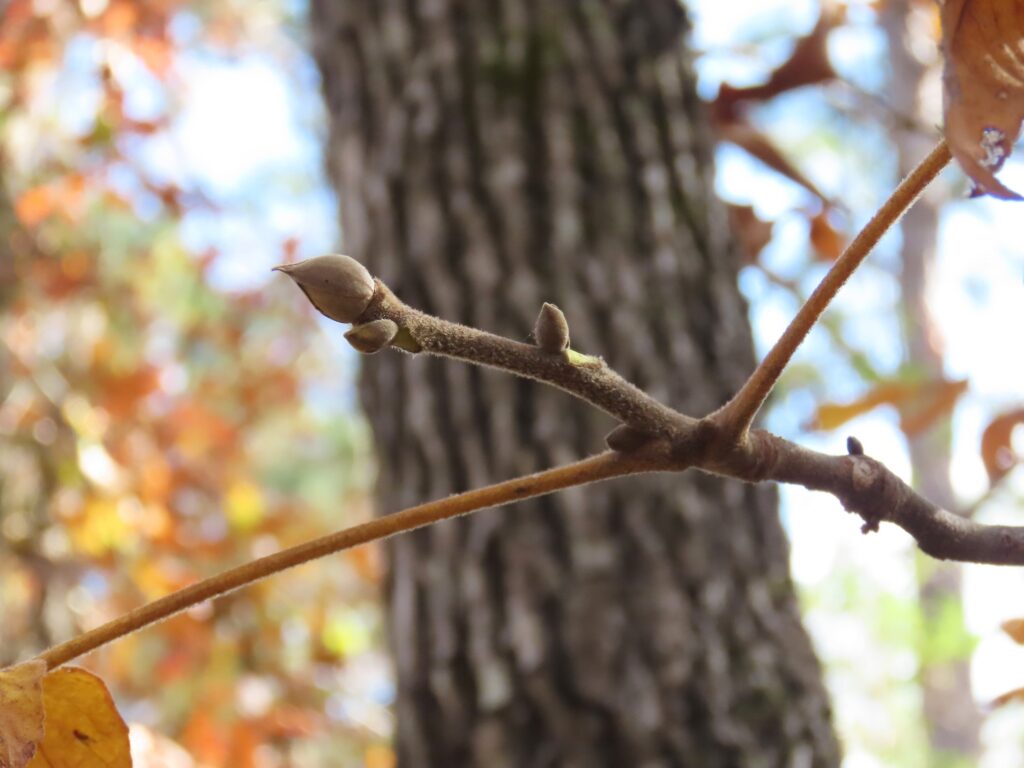
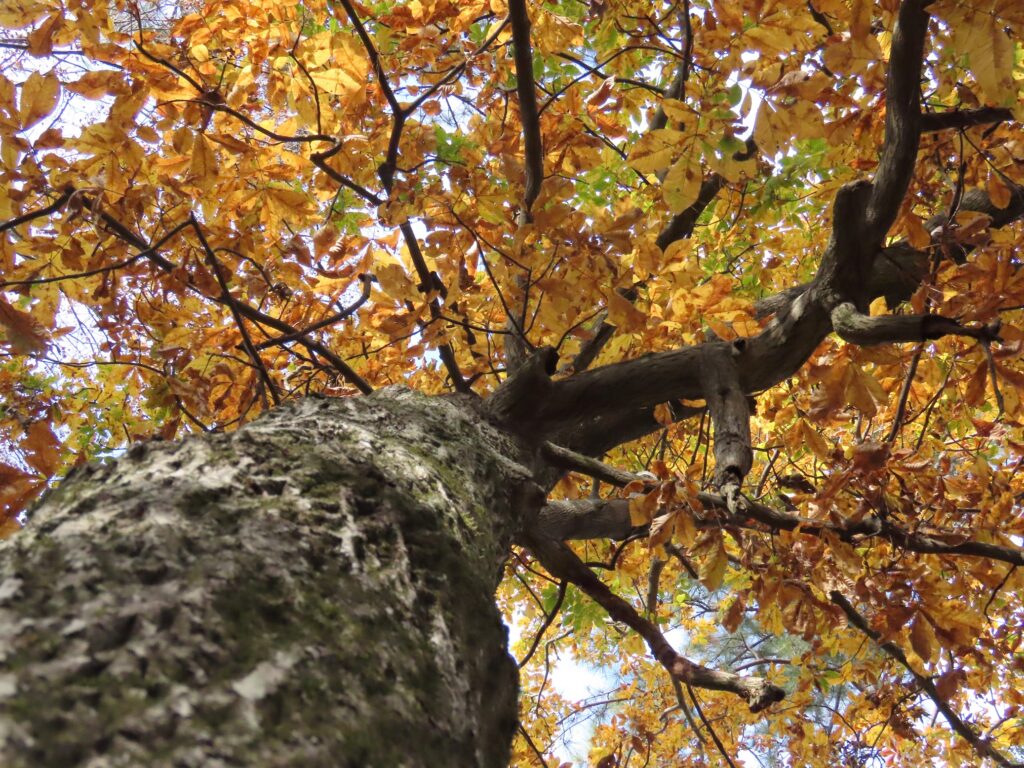
This week for Flora and Fauna Friday it’s one hull of a hardwood, the Mockernut Hickory (Carya tomentosa).
The Mockernut Hickory is a species of Hickory tree found throughout the Southeast and all of South Carolina. It’s highly drought tolerant and much prefers dry soils. It is just as much a common sight on the rocky ridge tops of the foothills and piedmont as it is on the fire pruned savannas of the sandhills, coastal plain, and sea island sand ridges. However, it’s also often found on richer soils that are sufficiently well-drained. This tree can eventually reach a hundred feet in height in forest settings, but generally is closer to seventy-five feet at maturity here in the Lowcountry. Its bark is dark gray, rather thick, and fissured with a blocky net-like pattern. This thick bark allows it to tolerate infrequent fire, although it’s not as fire dependent nor tolerant as many of our trees. Its leaves are compound, most often having seven broad leaflets, notably displaying wooly undersides, and can vary widely in total size from one to two feet in length. Here on the Sea Islands around the latter half of November, Mockernut and our other Hickories will release their fall colors, turning sharp shades of amber-yellow and candle-orange as they shed their leaves. About that same time in late October and throughout November, Mockernut Hickories begin to drop nuts. It’s a massive seed, often an inch wide, inch tall, and three-quarters of an inch thick, with a square profile, broad shoulders, and small point at the tip. The whole seed grows within a rind that is another quarter to three-eighths of an inch thick, making the entire fruit larger than a golf ball and nearly two inches around. This rind is dehiscent, meaning it splits as it dries in order to release the seed, and will itself be shed to the ground in four pieces.
Mockernut gets it common name from its seed. It’s a nut that makes a mockery of anyone who tries to get into it. The hull of a Mockernut seed is a full quarter-inch thick with many deep ridges that furrow the wrinkly, brain-shaped meat within. It’ll take two big rocks for you to get into one. And when you do, more often than not you’ve crushed the entire thing into oblivion. But even if you crack it cleanly, you’ll be granted only a paltry reward of meager nutmeat treats wedged irrecoverably between chunks of hull as hard as cement. Even though Mockernuts are perfectly edible to humans, they are practically impossible to make a living on. But that’s not the case for all wildlife. Mice, Woodrats, and Squirrels can use their ironclad incisors to chisel open the hulls and shell Mockernuts with relative ease. Deer and Turkeys will also gulp them down on occasion, but generally prefer any other nuts when available. These mammoth Mockernut Hickory seeds are primarily dispersed by squirrels, gravity, and floods. Squirrels will haul them up hills to stash for later, often forgetting a few that will later germinate. Trees growing on hilltops drop seeds that then roll downhill and settle on slopes and in valleys. Fall and winter flooding will float Hickory seeds downstream, depositing them inland when floodwaters recede.
What Mockernut Hickory lacks in value to humans as a food source, it makes up for in its value as a timber tree. Mockernut Hickory, being the most abundant Hickory in the Eastern United States, makes up the bulk of the Hickory wood grown and used in the country. Hickory is a stiff, tough wood that resists impacts and cracking very well, all while still being fairly light. This makes it the ideal wood for tool handles, particularly axes, hammers, and shovels that need to absorb a lot of repeated stress. The wood is also prized as a firewood as it burns hot, burns long, produces little smoke, and that smoke smells nice to boot. In fact, the smoke not only smells nice but tastes nice, and is regularly used in smoking and curing meats, particularly pork.
The Mockernut Hickory is one of eight species of Hickory tree found here in the Lowcountry. It shares this landscape with the abundant Pignut Hickory (Carya glabra), Sand Hickory (Carya pallida), Water Hickory (Carya aquatica), Bitternut (Carya cordiformis), and Pecan (Carya illinoinensis) as well as the locally scarce Shagbark Hickory (Carya ovata) and Nutmeg Hickory (Carya myristiciformis). Hickories all share a few common characteristics that make them an easy genus to spot. Their leaves are alternate and pinnately compound, generally with seven to eleven leaflets emerging from the mid-vein. One leaflet emerges from the tip and the remainder as opposing pairs shrinking in size as they get closer to the twig. Their barks tend to have a diamond-weave pattern, with vertical ridges that merge and split from each other, unless obscured in some species by flaky peeling plates. They’re all wind pollinated, and produce inconspicuous green catkin flowers in mid-spring. Their fruits are large, oblong nuts that are usually edible for humans and a dietary staple of many forest rodents. Underground, Hickories seedlings take advantage of their huge seed to grow a deep taproot when they germinate. This not only anchors them to the soil but affords them ready access to the local water table and deep soil nutrients that many other hardwoods can’t reach.
Of all these species, Mockernut Hickory is the most common Hickory you’ll encounter in South Carolina and much of the Eastern United States. However, Pignut Hickory is just as abundant here on the Sea Islands, if not a bit more. Telling a Mockernut from a Pignut is an easy feat. Habitat-wise on the Sea Islands, Pignut Hickory prefers coarser sands and younger soils with a water table readily accessible to their deep taproot. They also grow closer to the coast and can tolerate salt’s influences to a slight degree. Mockernut Hickory and Pignut Hickory are equally-sized trees, each readily attaining a height of seventy feet tall at maturity. At a glance, they look quite similar but differ in the finer details once scrutinized. Mockernut Hickory generally has a thicker, rougher bark toned a darker shade of medium-gray. Whereas Pignut Hickory has a smoother, less blocky barker that’s a paler gray. Their leaves are also a giveaway. Mockernut Hickory leaves are coarsely hairy, especially on the petiole near the base. Pignut Hickory leaves are totally smooth by comparison. This dichotomy is captured in their scientific names, with “Carya tomentosa” meaning “Wooly Hickory” and “Carya glabra” meaning “Smooth Hickory”. Their common names describe another dichotomy found in their fruits. Mockernut seeds are huge, square, and have a very heavy hull, making a “mockery” of anyone who attempts to crack them. Pignut fruits are smaller, more circular, and have a “pig nose” projection at the tip of their rind. Their nuts most often fall from the tree with this rind still attached. However, the name “Pignut” actually describes their historic importance in feeding semi-free-range pigs reared by early colonists, as the nuts are palatable and more readily cracked and digested by livestock compared to the Mockernut.
Sand Hickory is a less common lookalike to Mockernut Hickory found in many of the same habitats on the coast. Picking between a Sand Hickory and a Mockernut Hickory on the Sea Islands can be a difficult task. Both grow on dry sandy soils, have similar bark, and have hairy leaves. Sand Hickory, as a consequence, hides in plain sight and often gets written off as an under-sized Mockernut, even by seasoned ecologists and foresters. However, it’s not an impossible identification. Sand Hickory tends to have a silvery underside to its leaves and Mockernut Hickory instead a brass-colored fuzz below. Sand Hickory also has, on average, smaller leaves and more narrow leaflets. The twigs and buds of Sand Hickory tend to be svelter too. It’s also a smaller tree, generally only growing closer to forty feet tall. Their seeds as well are about two-thirds the size of Mockernut seeds, with a thinner rind and a more circular profile.

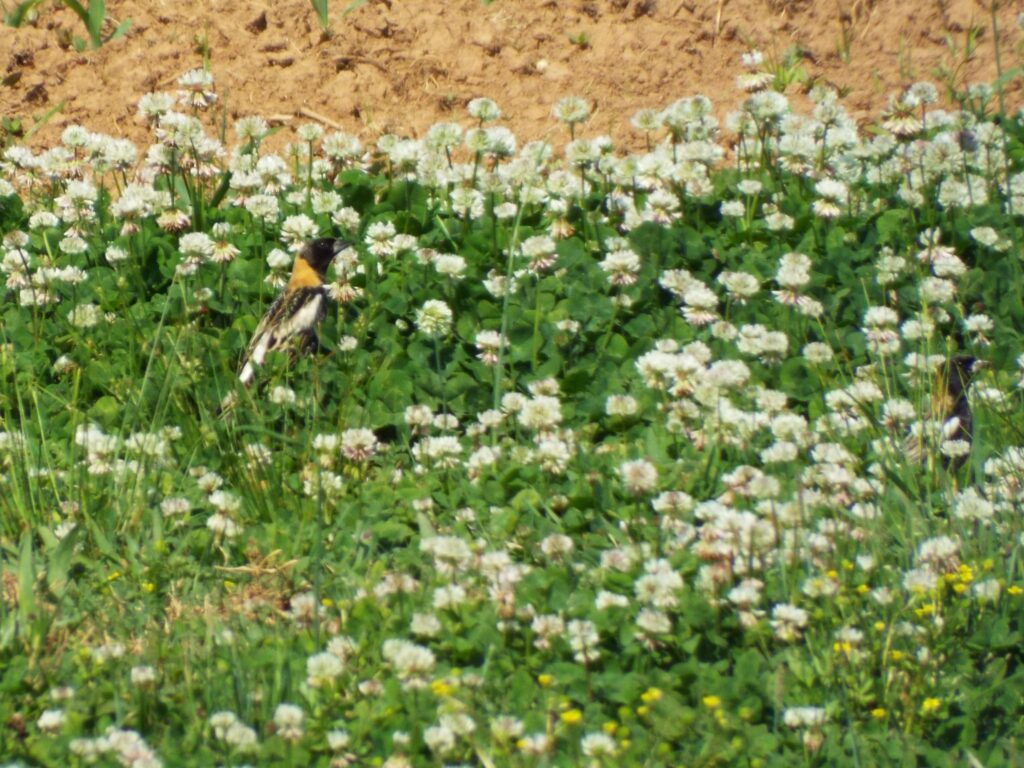
This week for Flora and Fauna Friday we watch for the descent of the infamous Rice Bird, the Bobolink (Dolichonyx oryzivorus).
Bear with me a minute as we cast our mind’s eye back some two-hundred years. Edisto Island, and the whole of the ACE Basin, looked quite different then. Sea Island Cotton blanketed nearly every inch of the sea islands’ sandy plains. In parallel between the upland and the saltmarsh, Carolina Gold Rice filled our swamps and freshwater marshes with tens of thousands of acres of golden, swaying grains. Just as surely as the rice would gild the marsh each autumn, a golden storm cloud would soon brew and descend upon it. Bobolinks, flocking by the thousands, once called the Lowcountry’s rice fields home, most unwelcome guests for the holiday season. Fast forward back to today and a mere dozen Bobolinks ‘most anywhere on the Sea Islands is a welcome sight to see.
The Bobolink is a mid-sized songbird in the Blackbird family, Icteridae. They’re a striking species unmistakable here for anything else. In spring, males flaunt a raven-black underside, silver shoulders and back, and a balding head of permed blonde locks. Quite the iconic fit. Fall males, and females year-round, look very different, but just as handsome. They wear streaky plumage of ebony-brown on the back diffused down into golden-tan on the belly, accented on the face with a strong pale eyebrow and dark line behind the eye. It’s a perfect camouflage for blending into the bending boughs of an overladen rice field. Their song is quite unique as well, a bubbly jumble of disjointed digital tones harshly strung together into a chaotic rambling.
Bobolinks spend their winters down in the plains of South America and nest in summer in the northern United States. They only pass through South Carolina during migration, briefly barreling through the State in spring but lazily lingering in fall here in the Lowcountry. They’re most often encountered in active agricultural fields, feasting on fallen grains and insects in small flocks, as well as in old rice fields within our tidal freshwater marshes, as if reminiscing of days long past. Back in the Antebellum during the heyday of Carolina Gold Rice, there was never such a thing as a small flock of Bobolinks, only imposing leviathan storms that came surging over the dikes, countercurrent to the September Gales. But that past is behind us.
Bobolink populations have declined tremendously over the last century. Before then, they ballooned well above their historic norms thanks to the consequences of European colonization and agriculture. Land clearing for agriculture in the northern United States expanded their nesting grounds, the same in South America bolstered their wintering grounds, and the booming rice industry in South Carolina gave them a fall feast along their southward journey that no bird could ignore. This cycle continued for a couple centuries, swelling the ranks of the Bobolink in kind. Here in South Carolina, the birds were seen as a nuisance and agricultural pest, but also a delicacy. Bobolink flocks were hunted by the thousands each fall, both for pest control and cuisine. Despite being small, their staggering abundance and the rich, buttery flavor of their meat made them a worthwhile target for market hunting. However, in the twentieth century, things changed rapidly. Rice culture had dropped off dramatically in South Carolina at the start of the 1900s and several laws prohibiting the market hunting of wildlife were passed in the first two decades. These factors de-coupled the Bobolink from our culture and cuisine here in South Carolina, turning it into a memory of the past. But regardless of being relegated to the annals of Charleston’s history, Bobolink populations continued mostly unabated range-wide for several more decades. Yet by the 1940s, agricultural practices began to shift in their northern nesting grounds. The tractor had thoroughly made its way to the prairies and plains, converting hayfields and native grasslands to neat fields of unsuitable crops for Bobolink nesting. This was followed by widespread insecticide use in the 1950s, decimating the populations of arthropods they relied upon to feed their young. Again in the 1970s came selective herbicides paired with advanced crop cultivars, obliterating the remaining native habitats and weedy field borders Bobolinks need to nest. Although there aren’t many hard numbers to lean on, evidence indicates towards a nearly 90% population loss since the turn of the twentieth century. A nearly two-thirds decline between today and the 1960s has been well documented by ornithologists.
The plight of the Bobolink is a dire fate shared by many grassland bird species across the United States. Prairies, plains, grasslands, savannas, pollinator habitat, snake-y lookin’ old fields, whatever you want to call them, they’re a habitat type that’s a rare commodity these days in much of this country. They’re also a bastion of biodiversity built by native plants and relied upon by scores of specialized animals. Species like the Boboloink can’t survive without them. Native grasslands are important not only to protect where still present, but also to create, restore, manage, and maintain where they historically occurred. They only exist today due to the divine intervention of natural disasters, or regular deliberate action by mankind. If we don’t intentionally protect and promote our grasslands, we’ll assuredly reap the ruin of our natural history and the loss of myriad species, to include our Bobolink.
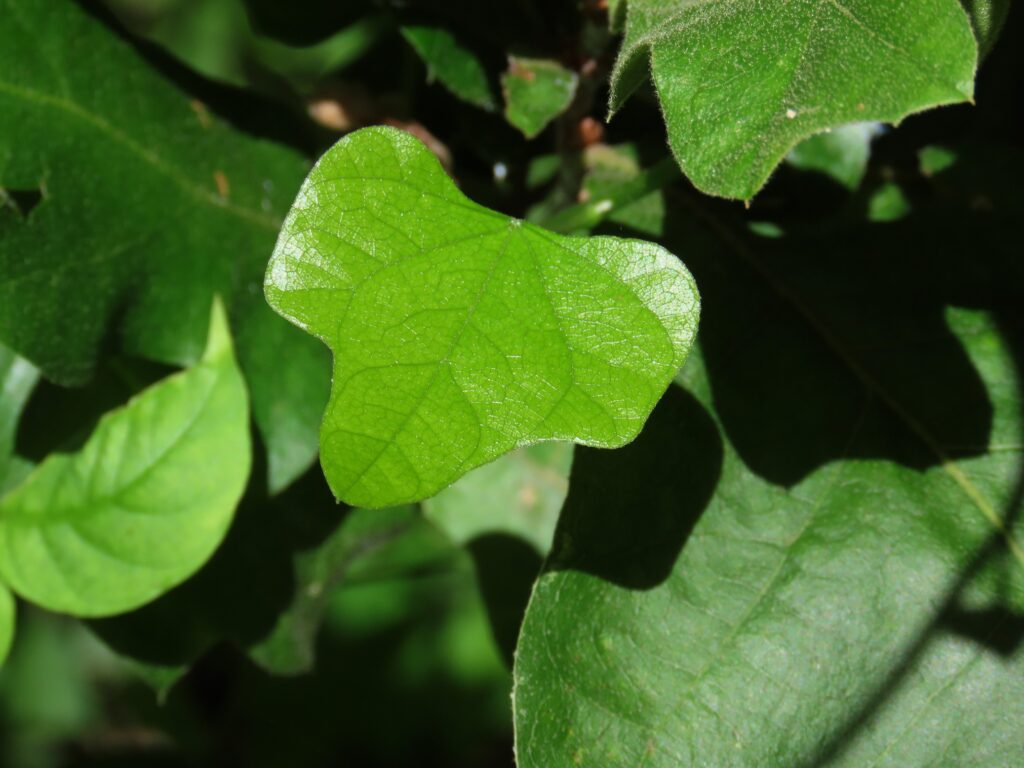

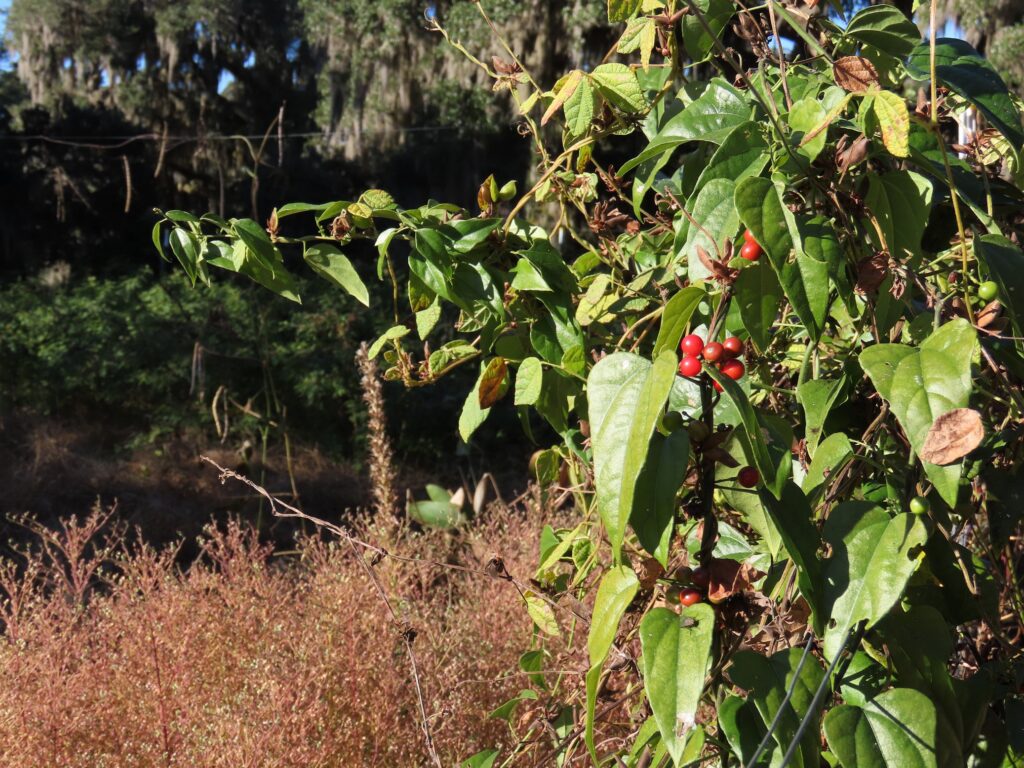
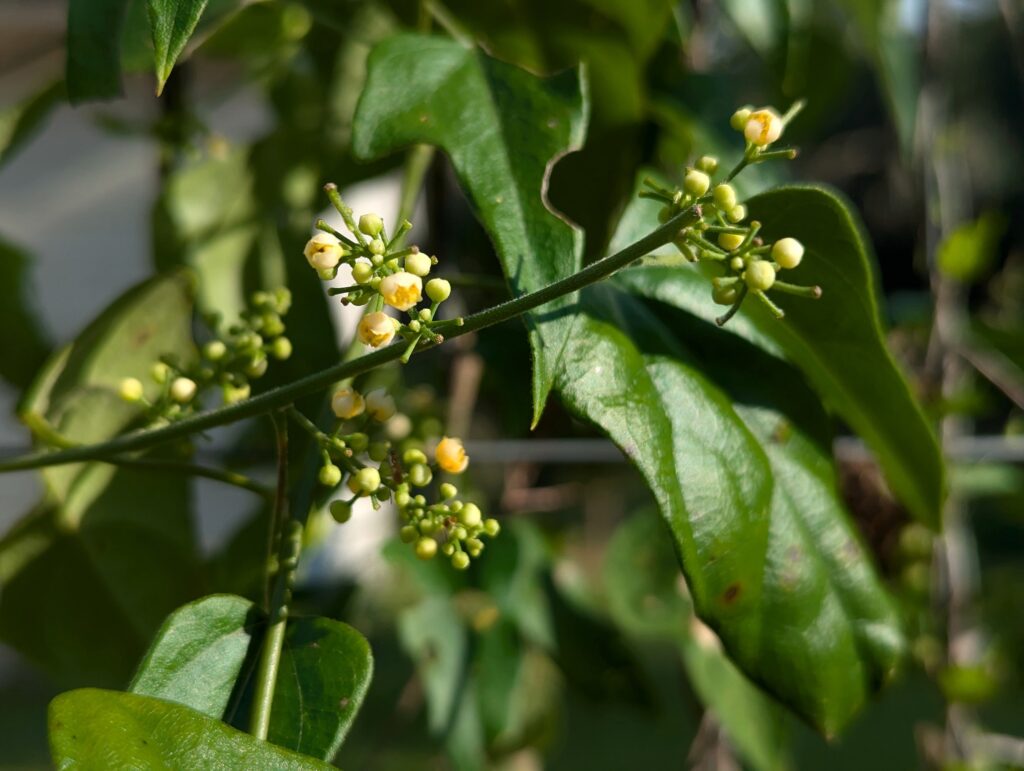

This week for Flora and Fauna Friday it’s a tri-lobed twining vine with a twisted seed, Carolina Snailseed (Nephroia carolina).
Carolina Snailseed is a perennial vine found throughout the South and all of South Carolina. It can tolerate a wide range of growing conditions, from the heavy shade of the forest floor to full sun on a fence row, and from the fertile floodplains to the barren sand ridges. It’s a very versatile vine. It grows by twining its narrow, wiry stem around vegetation and can reach about ten feet in height. Its leaves are a rich emerald-green, tri-lobed in shape, and leathery in texture, often with prominently sunken veins. Carolina Snailseed blooms in late spring throughout summer. Its flowers are tiny, cream-white in color, and bloom in small clusters along the stem below each upper leaf. These flowers, once pollinated, will mature in fall into brilliant, scarlet-red berries about a quarter-inch in size. Within each colorful berry is a single seeded secret surprise.
The seeds of Carolina Snailseed are large and helically twisted. They look just like a tiny snail shell, but with a rough exterior. Carolina Snailseed also goes by two other common names: Carolina Coralbead and Carolina Moonseed. Both of which are equally fitting, this plant having both coral-colored bead-like berries and also being a relative and visually similar to Common Moonseed (Menispermum canadense) which is found throughout the Northern United States and mid-South. But neither of these names are quite as iconic as “snailseed” in my opinion. Despite this plant having a snail-seed, it doesn’t spread at a snail’s pace. Carolina Snailseed is dispersed by birds, which eat the enticing red berries and then deposit the snail-shaped seed along a tree line, thicket, or fence some ways away. Here on the Sea Islands, Carolina Snailseed is often evergreen, thanks to our subtropical climate. These always verdant leaves paired with brilliant red berries make it a wonderful yard plant to train up a trellis or fence to retain some life into winter in your yard or garden, while feeding the birds to boot!





This week for Flora and Fauna Friday there’s a hunter in the dark, a wader in the shadows, the Black-crowned Night Heron (Nycticorax nycticorax).
As the cloak of twilight settles on the Lowcountry, the diurnal din dwindles with the dissolving glow of day. A croak, like stone on rock, a sudden nasal squawk, half rally cry – half shock, pierces the veil with the fear of the dark. It echoes from above, resonating in the lower spine, rising and shaking loose the frigid frisson of hairs on end as you stand frozen in silence, now beyond the threshold of the night. Terror thaws under warming recollection. ‘Twas merely a Night Heron, plunging excitedly into the darkness of an inverted dawn, in anticipation of the hunt.
The Black-crowned Night Heron is one of two Night Heron species found in South Carolina. The other being the Yellow-crowned Night Heron (Nyctanassa violacea), a more seasonal and scarce species that visits our coast in summer. The Black-crowned Night Heron calls our coastline and Sea Islands home year-round. They’re a wide-ranging species found across the tropics and temperate regions of the globe. Looking at the species in local context, they’re a stockier and shorter build than most of our other Herons and Egrets, a middling size by comparison but with and uncharacteristically short neck. They’re a shape and profile unlike any of our other waders. That uniqueness is further distinguished by their plumage. The Black-crowned Night Heron’s back and cap are a bluish slate-black, their wings smoky-gray, and their belly and throat pearl-white. From below all is upheld on golden legs, out in front juts a dark dagger of a bill, and peering out from the dividing line between a sky of black and a sea of white hovers in the horizon an imposing crimson eye. Like a setting sun pushing the blinding day away from the cloak of darkness. Juvenile birds are more subtly colored with the browns of weathered, fallen leaves plowed and peppered with bone-white in a blend made for blending in, and the only color expressed being a smoldering orange eye.
Black-crowned Night Herons, despite being common birds, are often hard to find. That’s owed to their nocturnal nature. Most wading birds forage throughout the day and huddle together in treetops for safety throughout the night. But Night Herons work the graveyard shift and so do the reverse. At the shuttering of dusk, they rouse and scatter across the landscape of the Lowcountry, squawking with rejoice as they commute. They’ll settle onto a bank of a wetland, pond, or creek and fish the night away below the illumination of starlight. They’re not picky eaters either, and will eat most anything they can catch and swallow. As dawn looms over the horizon, Black-crowned Night Herons return to their rooks. This is where you’re most likely to spot them. Overhead in a hedge or thicket overhanging a pond or marsh in a secluded corner, they hunker down in numbers to sleep the day away.



This week for Flora and Fauna Friday we’re on the lookout for the compressor of the canopy, the twister of twigs, the possessor of pines, the enigmatic Witch’s-Broom.
Witch’s-Brooms are an arboreal anomaly. They’re a dense, gnarled cluster of leaves and twigs twisted together into a rounded mass within the crown of a tree or shrub. Somehow, somewhere, for some reason, a switch is flipped in the inner machinations of a single new limb and it begins to grow wrong. Its twigs become condensed, growing only a fraction of an inch in length while still packing new buds into every millimeter of space. Each of these buds still bears its leaves, creating an impossibly dense ball of foliage. Over the years the mass will continue to grow, inch by inch. On some parent tree species these twisted twigs shoot upward in a dense fan, resembling the bound sticks in the head of a handmade broom. When you factor in the seemingly arcane origin of these aberrant tree growths, then you end up with the folk name of “Witch’s Broom” bestowed upon these mysteriously mangled limbs. It’s a moniker that implies a fleck of the dark arts or some whiff of black magic has nestled itself into your local woodlot.
Witch’s-Brooms occur on the limbs of a wide array of woody plants but, here in the Lowcountry, are most commonly seen and most impressively sized in the crowns of pine trees. When produced by a pine, a Witch’s-Broom most often appears as a small, dense hedge growing right in the middle of a tree, a nearly solid mass of needles some two to six feet wide. These Witch’s-Brooms materialize in maybe one in fifty-thousand Loblolly Pines (Pinus taeda), seemingly at random on the landscape. But, with how many Loblolly Pines we have in the South, that shakes out to about one every hundred acres, a half-dozen or so per square mile, or at least that’s the rate my gut indicates from my own anecdotal experiences. Thus they’re by no means a rare sight when looking at the landscape as a whole, but it’s by no means a guarantee you’ll find one on any given tract of land.
Witch’s-Brooms are not a discrete taxon of life we can define. Instead they’re a loose collection of botanical phenomena that lead to a similar end point, a common downstream symptom of a complex biochemical interaction within a host plant induced by an external influence. You can think of them like something between a tumor, a gall, and a wart. In many trees, Witch’s-Brooms are caused by an infection. Be it a fungus, virus, protozoan, insect, or arthropod, the most common offender varies greatly between different lineages of plants. But the common thread with most Witch’s-Brooms is that something has invaded the tissue of the plant, triggered an immune response, instigated biochemical warfare, and initiated a cascade of hormonal responses within the host plant which, ultimately, leads to inducing dense, congested growth of limbs and leaves. However, in Pines, sometimes the root cause is a little deeper. It’s the genes of the plant itself that mutate or are epigenetically suppressed by an outside stimulus, inducing a form of localized dwarfism in its crown. Over the decades, some ambitious and pioneering horticulturalists have even collected cuttings from Witch’s-Brooms and propagated them, resulting in true-to-type dwarf Pine trees!


This week for Flora and Fauna Friday we have a briny bicolor barnacle biter, the Sheepshead (Archosargus probatocephalus).
Sheepshead are a marine species of fish found along the East Coast of the United States. They live in habitats along the coast from the brackish marshes of our estuaries, to the briny back rivers of barrier islands, and down into offshore reefs and forgotten shipwrecks. Sheepshead are an easy fish to identify. Their body is marked with alternating heavy, vertical bands of white and black. They have a high-sloped forehead and grow to about the size and shape of a turkey platter, being twice as long as they are tall. Sheepshead average between a foot to foot-and-a-half in length at maturity, but old fish can readily reach double that size. Legally harvestable fish generally tip the scales at between three to fifteen pounds. If you’ve ever hooked one, you also know they have quite a set of pearly whites! Sheepshead have very human-like incisors, but behind that toothy grin is a mouthful of multiple rows of flat, grinding molars. Those teeth are the key to its success in a unique ecological niche here in the Lowcountry tidewaters.
Sheepshead make their living eating on stationary shellfish, mainly barnacles, oysters, mussels, clams, crabs, and just about any other crustacean they can sink their buck teeth into. As such, they are commonly found hanging around docks, marinas, piers, wharfs, reefs, wrecks, jetties, and any other hard structures encrusted in barnacles and oysters. To get their victuals they simply pluck barnacles from pilings, much the same way you’d bite corn off the cob. It’s a simple but effective strategy, especially now that man has filled the Lowcountry waterways with all manner of rip rap and timber for shellfish to stick to.
Conversely though, this habit makes Sheepshead a convenient target for recreational fishing as they hang out year-round right under the dock. Anglers with a South Carolina saltwater fishing license can harvest adult Sheepshead with a total length of at least fourteen inches (as of my writing this in 2025). Sheepshead can take some skill to properly hook, and a little more skill to properly fillet, but, if properly prepared, they’re an undoubtedly tasty fish once they make it to the table.